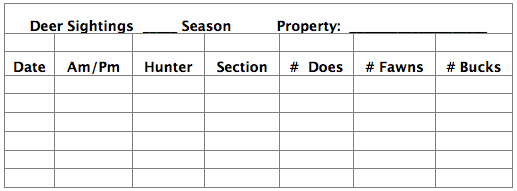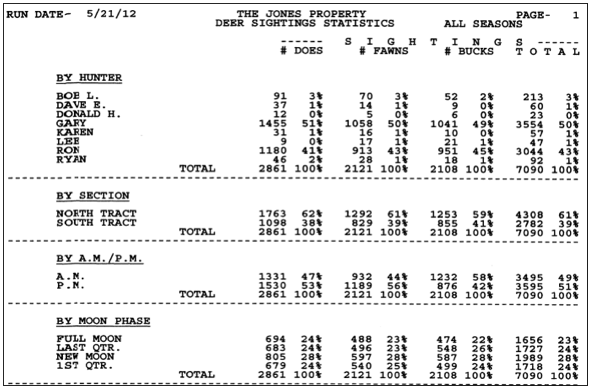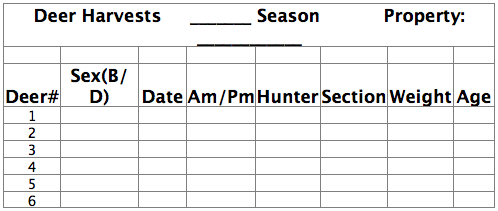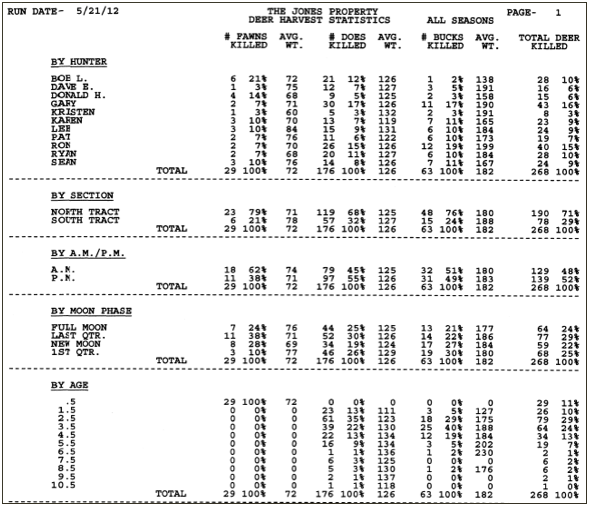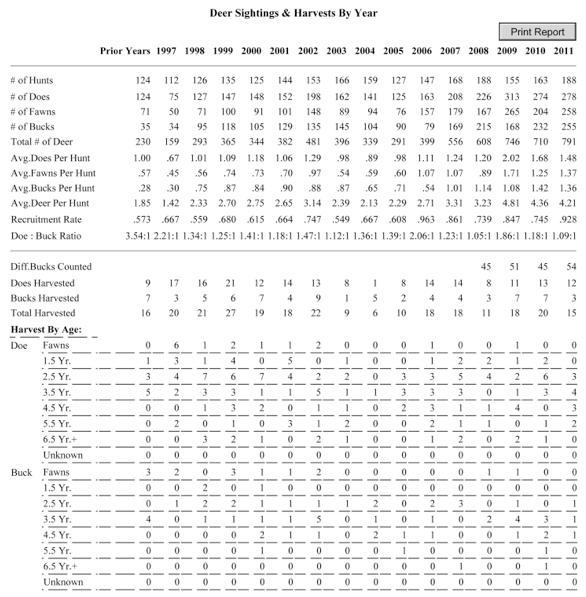Because I will be covering so much information I decided to break this information down into three articles. This first article will cover the monitoring of your deer harvests and sightings. Even if you feel that you can’t or don’t want to manage your deer population or whether you control 200 acres or 2000 acres you should at least keep track of your harvests and sightings. I briefly touched on this monitoring phase in my article “Can you Manage your Property?” I do understand that some of you may be in a situation where you may not even care about your sightings from season to season. Maybe you only hunt a couple of days each season or maybe you hardly ever see a deer but if you do want to keep track of your harvests and sightings you should be doing this monitoring phase. This monitoring is accomplished in the Basic Version of our software. I will now go into more detail of what we do in this monitoring phase. Even though some properties like to enter their actual deer sightings from each hunt most properties prefer to do a trail camera survey. Please read my article “How I use my Trail Cameras” where I explain what this is.
After each hunt we write down the date, am or pm, hunter, section hunted (optional) and how many Does, Fawns and Bucks we saw. The date is important because we will automatically retrieve the moon phase for that date and thus you will establish a history of your sightings by moon phase. This doesn’t mean much for one season but it is very interesting to see after you have several seasons of history entered. You will also get your sightings broken down by Am/Pm, Hunter and Section. Here is a reduced size of what the form looks like.
It only takes a couple of minutes to write down the sightings for all of us. Who you include in these statistics is up to you. Just remember that when you are dealing with statistics the more data you have the more representative your results will be. You don’t have to write the sightings down for all of your hunters. You may decide to include only members and not guests since the guests may not be able to clearly identify your deer like you can. We have times when we don’t get a good look at the deer ourselves in which case we don’t count it at all. Try to have sightings entered from throughout your property so you will be getting a good sampling from your entire property and not just one section of it. In our situation if I am exclusively hunting the South Tract and no one else is recording sightings from the North Tract then all of our statistics will be based on just my sightings on the South Tract which could be misleading. You may decide to have everyone write down their sightings or only have certain people participate. Again this depends on your own specific situation. If you are doing a trail camera survey then just put the last date of your counts and the total number of Does, Fawns and Bucks that you counted.
The only column on the form that may need explaining is “Section”. If you want to break down your property into different sections you will get your sightings broken down by section. For example we have our property broken down into the North Tract and the South Tract. The South Tract makes up about 1/3 of the property and yet it contains about 60% of our food plots. It is very easy for us to designate that we hunted in the North or South Tract. You will see in my sample below how we get our sightings broken down by section. (North Tract and South Tract) If you wanted to you could set up each of your deer stands as a section and get your sightings for each deer stand but this could get real complicated if you are moving your deer stands around. So if you want to keep it real simple just ignore the Section and write down everything else.
Here is the Deer Sightings Statistics:
The report above can be run for a specific season or for multiple seasons combined. Remember that the sightings above are just a count of how many deer we saw on each hunt. If I see the same Doe 20 times throughout the season then she is counted 20 times. I don’t want you to think that we have had 7090 deer on our property since 1996. Since this report is for sightings I don’t use the recap by hunter very much but the other three breakdowns are interesting. The percentage shows that 62% of our Doe sightings have been on the North Tract while 38% have been on the South Tract. The Total sightings show that 61% of our total deer sightings have been on the North Tract and 39% have been on the South Tract. This makes perfect sense to me since the North Tract accounts for two thirds of the property and yet the South Tract contains 60% of our food plots. I used to think we saw more deer on the morning hunts but as you can see the total sightings are about equal between morning and afternoon hunts for us. But, I do find it interesting that we have seen 58% of our Bucks on our morning hunt’s versus only 42% on the afternoon hunts. We’ve always noticed that the older Bucks have a tendency to wait until it’s dark or just about dark before they start moving around in the late afternoons. I also used to think that the deer didn’t move well during the day on a full moon but as you can see above there is not a significant difference in the sightings by moon phase for us. This report serves no management purpose for us but since we have the information it is interesting to see if we have any patterns showing in the above breakdowns. Also, if you are just entering your trail camera counts then just ignore this report.
The other thing we keep track of and most importantly are our deer harvests. Again, we simply write down this information during or after we weigh, age and dress out the deer. There is another form for the people who want to use the Advanced Version of my software which will include some antler measurements. If you are not planning to get into antler analysis for antler restrictions then the information on this form is more than adequate. Here is a reduced size of what that form looks like.
On the form the first thing we indicate is the deer number. Just start at the number one each season and increment it thereafter. The first deer harvested will be deer# 1, the second deer harvested will be deer# 2 etc. Next we indicate if it was a Buck or a Doe. Again the date is important because it will automatically retrieve the moon phase which is just like the sightings and you will be able to see if there is a pattern to your harvests in relation to the moon phase. Indicating morning hunt or afternoon hunt provides interesting information as well. Have all of your hunters set up so you can record your harvests by the actual hunter. Again this can be real interesting, not necessarily for just the current season but over several seasons. I will be honest with you, if it wasn’t for keeping these records I would have no idea how many deer I have shot over the last few years. Section is the same as I described above for the sightings form. If you don’t have yourself a scale then you should get one. We are pretty good at estimating the weight of a deer but usually we are off a few pounds on our guess. I don’t ask for whole weight and gutted weight. We simply weigh the deer before we dress it out so we consistently use whole weight. If you prefer to use the dressed out weight that is fine as well, just be consistent. Don’t use whole weight one time and dressed out weight another time.
Because of its importance I am going to start a new paragraph here. The last column on the form but not the least important is the age. Age is one of the most important factors in deer management. Unfortunately, determining the age of a deer jawbone isn’t 100% accurate. Ageing a fawn, 1 ½ and 2 ½ year old jawbone is accurate most of the time. The accuracy goes down at 3 ½ and then goes down more at 4 ½ plus. We try to maximize our accuracy during Hunting Season (when they are in rut) ageing Bucks that are 3 ½ years old and older by using the jawbone in conjunction with the body characteristics. We had one Buck in particular a few years ago that we were confident was 3 ½ years old. We determined this by analyzing our trail cam pictures. He had heavy and wide antlers but was basically a 6 pointer. He was on our hit list and I was fortunate enough to be able to shoot him. When I pulled the jawbone I was shocked to see that it showed him as 2 ½ years old. At that point I decided to pull the other side of the jawbone and guess what. It showed him as 4 ½ years old. I figured I would just split the difference and call him 3 ½ which is what we thought he was. This was a valuable lesson though because ever since then if we ever question the jawbone age versus the body characteristics we go ahead and pull the other side of the jawbone. For what we are doing if we can age Bucks at 4 ½ plus this fits right into our own specific management plan. If you don’t know how to age a jawbone then you should go on the internet and research ageing deer jawbones. There are numerous articles and even videos showing you how to do it including how to remove the jawbone. Please watch my video “How to remove a Deer jawbone”. If you are unable to age a jawbone then I would suggest that you pull the jawbone, identify the deer it is from and save it so someone can age it later. You can always go into the computer later and enter the age. I actually wipe the jawbone dry and then use a permanent marker to write the season and Deer# on it. If you have no desire to mess with the jawbone then just ignore the age. Even without the age you will still get some valuable information about your deer population. Except for the age and possibly the weight (because you don’t have a scale) you can definitely write down all of the information needed on the harvest forms. If you can just do that here is the information you can get as a result of that data.
The next report we get is the Deer Harvest Statistics:
The report above can be run for a specific season or for multiple seasons combined. It analyzes the deer that we have harvested. The breakdown by hunter allows us to see how many deer we have each harvested. It doesn’t feel like I have shot that many deer but like I said before it’s hard to remember all of this. (Actually, it is impossible for me to remember). It shows that Gary has shot 2 Fawns which is 7% of the Total Fawns killed, 30 Does which is 17% of the Total Does killed and 11 Bucks which is 17% of the Total Bucks killed for a Total of 43 Deer which is 16% of the Total Deer killed. I used to think that we shot more deer on the morning hunts but as you can see the harvests are about equal between morning and afternoon hunts for us. Just as you saw with the sightings report there is not a significant difference in the harvests by moon phase for us. The moon phase of last quarter has a slight edge but again there is not a significant statistical difference. The recap by age is the most interesting because we can see how many deer we have harvested in the different age groups. In a properly managed property you should see deer harvested in different age groups. Look how most of the Bucks we have shot were 2 ½(29%), 3 ½(40%) and 4 ½(19%) years old. The percentage of 2 ½ year old Buck’s should continue to go down now because we are now doing our best to NOT shoot any 2 ½ year old Bucks. If you find that you are shooting a lot of 1 ½ year old deer then this may explain why you aren’t shooting many older deer. (The deer aren’t being given a chance to get to an older age class) The breakdown by age is the only breakdown where the average weight can mean anything. The other breakdowns have all the ages combined. I’m embarrassed to show how many fawns we have accidentally shot but 25 of them were during our first seven years of hunting this property. Unfortunately when you are shooting a lot of Does it is inevitable that you will be shooting some fawns, especially when we have some button bucks that weigh about 100 lbs. The good news is that we have only shot four fawns over the last nine years. Also, we have not shot any yearling Bucks over the last 11 seasons which we are happy about.
As a result of entering your sightings and harvest information you can also get a season by season comparison of various information that you can use to see if things are looking better, worse or about the same.
The following report is our most important monitoring and management report!
This report shows information for the last 15 seasons and prior. Just ignore the 1st five lines of information because they aren’t meaningful in our analysis. They are just a total count of our hunts and the total sightings on those hunts. What we are interested in is the average Does, Fawns, Bucks and Total Deer per hunt. If we go on 100 hunts and see a total of 100 deer that is an average of 1.00 deer per hunt. If we go on 50 hunts and see a total of 75 deer that is an average of 1.50 deer per hunt. The sightings were actually better for the season where we had 50 hunts. Start with the Avg. Does, Fawns, Bucks and Deer per Hunt. This is where I can see if our sightings are going up or down. What I want to point out is that in 2006 we began adding more food plot acreage and we started our supplemental feeding of protein pellets and mineral licks. This definitely attracted more deer to the property. The factors will obviously vary every season and unless I see a big change I don’t concern myself. For example if I see my sightings go from 2.70 to 1.80 then I will be monitoring that the next season to see if the trend still exists. If you are entering your trail camera counts then you will see the recruitment rate and Doe to Buck Ratio calculated from your counts.
The recruitment rate will give you the percentage of Fawns to Does. For example if I see 2 Does and 4 Fawns the recruitment rate is “2.00”, if I see 2 Does and 1 Fawn the recruitment rate is “.50”. Since this recruitment rate is calculated using your sightings during hunting season it may not be as accurate as a camera survey done just before hunting season but it will still give you a feel for your recruitment rate and give you something to compare to year to year. The reason it may not be as accurate is that if you are shooting Does then you will be continuing to count the Fawns she had throughout the remainder of the season but you obviously won’t be counting that Doe any more. Likewise if you are shooting Fawns then you may be continuing to count the mother Doe for the remainder of the season but will not be counting her fawn. I always know if we are shooting Does early in the season and I take into consideration that the rate may be a little high. This is why I recommend that you do a camera survey prior to the season even if you are recording your actual sightings. This way you can compare the rates from the survey to the rates based on your sightings. In the Advanced Version of my software you will see how I use the recruitment rate for some pretty cool stuff.
The Doe to Buck ratio shows you how many Doe’s you have for one Buck. Again this is calculated using your sightings information. If I count a total of 20 Does and 5 Bucks then the ratio is 4.00 : 1 . (Four to one) Again, this is calculated during hunting season so it may not be as accurate as a camera survey done just before hunting season. Also, if your Bucks are pretty much nocturnal your Doe to Buck ratio will probably be high on this report because you aren’t seeing a lot of the Bucks. This is why I recommend that you do a camera survey even if you are recording your actual sightings. This way you can compare the rates from the survey to the rates based on your sightings. As I have stated before you need to know your own specific situation. Just like the recruitment rate you will see how I use the Doe to Buck ratio in the Advanced Version of my software for some calculations as well.
The Does, Bucks and Total Harvested are valuable information because you can see how many deer you have harvested each season. Below that the harvests are broken down by age. This allows you to see all of the deer that you have harvested each season broken down by age group. If you don’t enter the age when you key in the harvest information then they will simply show up under unknown.
So in summary, if you and your co-hunters will simply write down your sightings or do a trail camera survey and also write down your harvests during the season and have someone enter them into the computer then you will be able to run the three reports that I showed above. You will be able to see your Deer Harvest information by Hunter, Section, am/pm, Moon Phase and Age. You can do this for one season or multiple seasons. You can also monitor how many deer you are seeing or your trail camera counts season by season. Being able to see how many Does and Bucks you have harvested each season is great information to have and it’s even greater if you can enter the age of the deer. Also, let me point out that I haven’t said a thing about shooting deer or not shooting deer from a management perspective. Even if you aren’t interested in deer management or you just feel that you can’t manage your property you should still keep track of your harvests and sightings or camera counts which I allow in the Basic Version of my software.
If you are interested in going into the next phase of management please read my next article “Deer Management Phase II (Determining Harvest Requirements)”.

